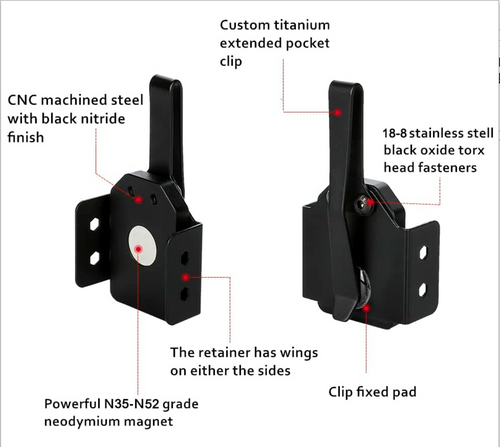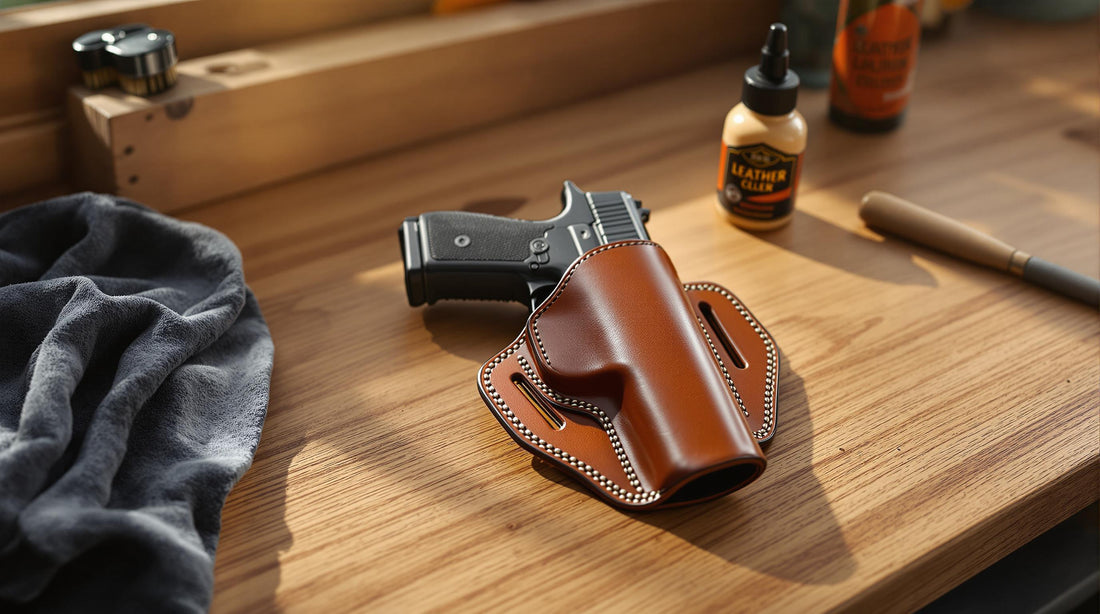Your IWB holster needs regular care to stay safe, functional, and long-lasting. Neglecting maintenance can lead to safety risks, performance issues, and even damage to your firearm. Here’s a quick breakdown of what you need to do:
- Clean and Dry Regularly: Use proper cleaning methods for leather and Kydex holsters. Avoid harsh chemicals and let leather air dry at room temperature.
- Check Retention: Test your holster’s retention by performing dynamic movements while wearing it. Adjust screws gradually for the perfect fit.
- Inspect for Damage: Look for soft spots, loose screws, or cracks in key areas like the trigger guard, retention points, and belt clips.
- Store Properly: Keep your holster in a cool, dry place away from direct sunlight or moisture. Use silica packs for added protection.
- Maintain Moving Parts: Lubricate retention points and screws with safe products like silicone-based or dry lubricants.
Quick Tip: Clean your holster every two weeks and inspect it monthly to avoid issues. A damaged holster isn’t worth the risk - replace it if necessary.
These simple steps ensure your holster stays reliable, safe, and ready for daily carry.
ANR DESIGN Re-Education Series: Holster Maintenance

How to Clean and Dry Your Holster
Keeping your IWB holster clean and dry is key to ensuring it works well and lasts a long time. The cleaning method you use depends on the material of your holster.
Cleaning Leather vs. Kydex Holsters
Leather Holsters: Start by wiping off surface dust with a soft cloth. For deeper cleaning, use lukewarm water and glycerin soap. Stay away from harsh chemicals or oils like Neats Foot or Mink oil, as these can damage the leather. To help repel moisture, apply a light coat of spray silicone on the inside.
Kydex Holsters: Use a damp cloth to wipe down the holster. For tougher grime, mild detergents work well. If there’s heavy buildup, scrub gently with a stiff-bristled brush, soap, and water.
Here’s a quick guide to cleaning products:
| Material | Safe to Use | Avoid |
|---|---|---|
| Leather | Glycerin soap, lukewarm water, spray silicone | Neats Foot oil, Mink oil, harsh chemicals |
| Kydex | Mild detergents, multi-purpose cleaners, damp cloth | Abrasive cleaners, harsh solvents |
Safe Drying Methods
Drying your holster the right way helps maintain its shape and durability.
Leather Holsters: Let them air dry at room temperature. While the leather is still damp, reshape it as needed. Use a clean cloth to pat it dry, and avoid placing it near direct heat sources.
Kydex Holsters: Wipe them down with a dry cloth, making sure all retention points are free of moisture. Check crevices for water spots, and let the holster air dry in a well-ventilated space.
Setting the Right Retention
Getting your holster's retention right is key for safe concealed carry. It ensures your firearm stays secure during movement but can still be drawn quickly and without obstruction.
Testing Your Holster's Retention
Forget the shake test - it doesn’t account for the pressure from your body or belt. Instead, try this:
- Unload your firearm and use a safety device like a Barrel Blok.
- Wear your holster as you would daily.
- Perform dynamic movements like jumping jacks, burpees, quick sprints, or hip bridges to see if the firearm stays secure.
If your firearm remains in place during these activities, your holster’s retention is on point. If not, tweak the hardware.
Adjusting Retention Hardware
Fine-tuning your holster's retention is a step-by-step process. Use this guide for adjustments:
| Step | Purpose | Key Tip |
|---|---|---|
| Initial Reset | Start fresh | Loosen all screws completely. |
| Basic Setup | Set a baseline | Tighten each screw half a turn. |
| Trigger Guard | Minimize excess movement | Focus on screws near the trigger guard. |
| Final Adjustments | Personalize retention | Make small, gradual changes. |
Keep in mind that body pressure while wearing the holster will affect how tight it feels. After each adjustment, test your draw to find the right balance of security and ease of access.
Once everything feels right, take a moment to inspect your holster for any signs of wear.
sbb-itb-7fb5bb8
Checking for Damage
Regularly inspecting your holster helps avoid safety risks and keeps it in good condition for longer. Pay close attention to areas that are prone to wear and tear.
Common Wear Points
Check these key areas for signs of damage:
| Wear Point | What to Check | Warning Signs |
|---|---|---|
| Trigger Guard Area | Shape and material | Softening, creases, deformation |
| Retention Points | Hardware condition | Loose screws, material breakdown |
| Belt Clips/Loops | Mounting points, clip flexibility | Stress cracks, loose attachments |
| Sweat Guard | Material condition, stitching | Separation, material breakdown |
| Mounting Hardware | Screw holes, threading | Enlargement, stripping |
Leather holsters require extra attention. Damage near the trigger area can create serious safety concerns.
Evaluate your findings to decide whether the affected parts need repair or full replacement.
When to Fix or Replace
Use the wear points you've identified to decide on the next steps.
Replace immediately if:
- Leather near the trigger guard becomes soft or shows creases.
- Retention fails even after adjusting the hardware.
- Mounting points have visible stress damage.
Repair is an option when:
- Screws simply need tightening.
- Surface wear is minimal.
- Belt clips are slightly loose and need adjustment.
- The sweat guard shows early signs of wear.
"If your leather is getting soft and worn, be sure that it won't interfere with your trigger or just replace it." - The ITS Crew
For Kydex holsters, some polishing of your firearm's finish is normal over time and doesn't impact performance. However, if you notice unusual wear - especially around the trigger guard - inspect your holster more closely.
A damaged holster isn't worth the risk. If you're unsure about its condition, prioritize safety and replace it rather than attempting to extend its use.
Correct Storage Methods
After checking for damage, storing your holster the right way is crucial to maintaining its condition. Proper storage helps prevent wear and keeps retention intact.
Temperature and Moisture Control
The environment plays a big role in the longevity of leather and Kydex holsters. Too much moisture can lead to mildew, while heat or direct sunlight can dry out and crack materials.
| Storage Location | Risk Level | Potential Issues |
|---|---|---|
| Car Dashboard | High | Temperatures over 150°F may deform the holster |
| Garage/Attic | High | Fluctuating humidity causes material stress |
| Climate-controlled Room | Low | Minimal risk |
| Bathroom/Basement | High | Moisture can lead to mildew and damage |
To keep your holster in top condition, aim for storage temperatures between 65-75°F and a low-humidity environment. If you live in a humid area, silica gel packs or a small dehumidifier can help keep moisture at bay.
"Keep in mind that heat might quickly deform your holster... On a chilly day, experiments demonstrate that a holster left in its product packaging (clamshell) in direct sunshine can achieve temperatures of over 150 degrees Fahrenheit and distort." - Kom News
Now, let’s look at the best storage tools for protecting your holster.
Storage Equipment Options
The right storage equipment can help maintain your holster's shape and condition.
For Leather Holsters:
- Wrap in a soft cotton cloth and store in a shaded case to shield from dust and light.
- Use vertical organizers to help the holster keep its shape.
- Add moisture-absorbing packets to storage containers.
For Kydex Holsters:
- Use padded organizers to prevent scratches.
- Keep away from heat sources to avoid warping.
- Store in a way that avoids pressure on retention points.
If you're storing a holster with a firearm inside, check daily for:
- Moisture buildup
- Condensation on metal parts
- Early signs of rust or corrosion
"Leather needs to breathe, and should be stored in a cool, dry place when not in regular use. High humidity can cause mildew, while dry heat and direct sunlight can cause drying and cracking." - Bianchi Leather
For leather holsters, periodic inspections and dust removal are essential, even during long-term storage. This routine maintenance can help you spot and address issues early.
Maintaining Moving Parts
Taking care of moving parts goes beyond cleaning and storage - it’s key for dependable daily use. Regular lubrication can improve draw speed (from 1.1 to under 1.0 seconds) and ensure secure retention.
Selecting Lubricants
Picking the right lubricant keeps your holster working smoothly without damaging its materials. Different components may require specific lubricants. Here’s a quick guide:
| Lubricant Type | Best For | Benefits | Notes |
|---|---|---|---|
| Silicone-based | Kydex & plastics | Protects materials, clean finish | Needs frequent reapplication |
| Dry lubricants | All materials | Doesn’t attract dirt, stays clean | Follow manufacturer instructions |
| Lanolin-based | Mixed materials | Safe for most holsters | May require extra cleaning |
Lubricant Application Steps
- Preparation: Clean and dry all moving parts thoroughly.
- Application: Apply a thin, even layer of lubricant to all moving parts.
- Testing: Test the draw several times to ensure smooth operation.
"Both oil and grease will degrade over time, meaning periodic reapplication would be a good idea. My general recommendation for doing this is either on a monthly basis or whenever the gun is shot, whichever comes first."
– George Harris
Stick to a regular lubrication schedule to keep your holster performing at its best. Pay extra attention to retention points and adjustment screws since they experience the most wear. Proper lubrication eliminates unnecessary friction, helping you maintain "true" retention.
Incorporate these steps into your routine to ensure your holster stays reliable every day.
Conclusion: Regular Care for Long-Term Use
Following the steps outlined earlier, sticking to a regular care routine helps keep your carry setup in top shape. Taking care of your IWB holster not only ensures safety but also extends its lifespan. A well-maintained holster provides secure retention, smooth draws, and reliable performance for daily carry.
Clean your holster every two weeks and do a deeper cleaning every few months using recommended products. These tasks - cleaning, retention adjustments, and hardware checks - work together to ensure dependable performance.
"Even if you don't carry your holster every day, it still gets dirty/dusty/dry or gunky. Carrying a firearm is an important responsibility so treating your holster with care to maintain its functionality is important, too." - Travis Pike
Make it a habit to inspect the hardware regularly and store your holster in a cool, dry spot away from direct sunlight. A poorly maintained holster can be just as risky as a malfunctioning firearm, so regular upkeep is non-negotiable.
Stick to these practices, and your holster will stay reliable for years to come.




